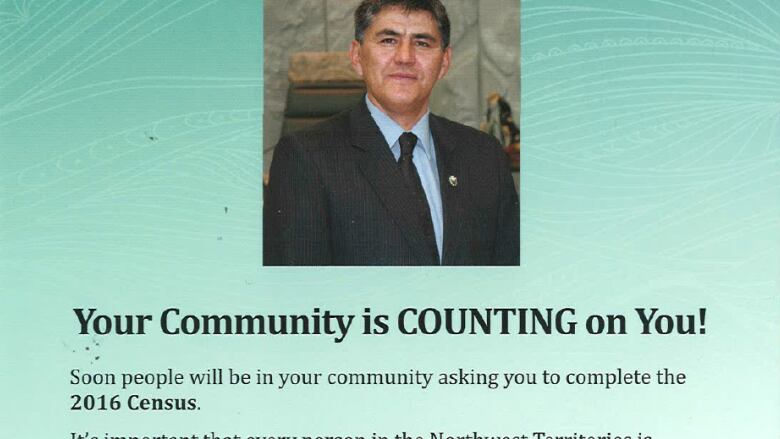Fill out 2016 census or N.W.T. loses out on federal cash, says finance minister
Census count is mandatory and affects territorial funding

N.W.T.'s finance minister is imploring residents to take part in the 2016 census so that the territory doesn't miss out on federal transfer payments at a time when the territorial governmentexpectsto be short on cash.
"Your community is COUNTING on You!" reads a pamphlet from Finance Minister Robert C. McLeod that began appearing inNorthwest Territories mailboxes last week.
Such outreach is not unusual the N.W.T. Bureau of Statistics has actively encouraged people to fill out the census since 2001 but the timing is key this time around.
While the population count recorded in the 2016 census won't affect the territory's transfer payments likely until 2019, by that point the territory is projected to be in deficit.
"It's important every person in the Northwest Territories is counted," said McLeod in the pamphlet.
"The federal government uses the census population as a base for funding to the N.W.T., and the territory receives approximately $35,000 per person, every year, for each N.W.T. resident."
The good news is, enumerators go door-to-door in communities outside Yellowknife to help people fill out the census.
"It ensures that they can hit every single household in each of our smaller communities," said Vishni Peeris, astatistician with the N.W.T. Bureau of Statistics.
Enumerators are expected to begin canvassing people in Hay River and Norman Wells on Friday.
Short-form versus long-form
Most residents will be asked to fill out the short-form census, which counts the people living in a household. Randomly selected households will receive the long-form census that asks about a dozen questions. Filling out the form your household receives, short or long,is mandatory.
A good census response rate doesn't just ensure the territory wrings as much money as possiblefrom the feds.Peerissays it also provides a trove of useful information to help the government plan its programs and services.
"It's one of the only sources that provides such detailed, community-level information about a huge variety of topics like language use, housing, employment, education levels," she said.
"It's one of the few places that collects your mother tongue, the language you first learned in childhood and still understand. It talks about the languages you're able to speak in, that you use at home. Those are really important pieces of information for the North."
Individual people's informationcollected in the census is kept confidential,Peerisstressed.
"When Statistics Canada enumerators come to anyone's door, they indicate that, by law, any data collected in the census is strictly confidential and cannot be shared with any other government departments or agencies," she said.
"That kind of sharing of information does not happen with census."
The last long-form census, conducted in 2006, received a 97.6 per cent response rate in the N.W.T. When it was replaced by the National Household Survey which was not mandatory in 2011, the territory's response rate dropped to 83.9 per cent.
The Liberal government has reinstated the mandatory long-form census for 2016.
The census can also be completed online starting May 2.












_(720p).jpg)


 OFFICIAL HD MUSIC VIDEO.jpg)
.jpg)



























































































